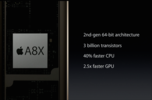
Recensione Complete del Tablet Apple iPad Air 2 (A1567 / 128 GB / LTE)
Apple A8X | PowerVR GXA6850 | 9.70" | 444 gr

L'Apple A8X è un SoC high-end ARM (System on a Chip) introdotto nell'ottobre 2014 con l'iPad Air 2. I tre cores CPU hanno un clock leggermente superiore rispetto ai due dell'Apple A8 (+100 MHz). Apple dichiara un miglioramento del 40% rispetto all'1.3 GHz dell'Apple A7 rispetto al 20% dell'A8. Inoltre , l'A8X integra una GPU più potente (2x 4-core PowerVR Series 6XT (Rogue) GXA6850) ed un controller di memoria da 128-bit LPDDR3.
Architettura
Con Cyclone 2, Apple ha provato a migliorare le già elevate prestazioni per clock dell'originale core Cyclone (Apple A7) di un ulteriore 10 - 15 percento. Né il Qualcomm's Krait né l'ARM Cortex-A57 possono competere con l'IPC. Le esatte modifiche del design non sono state rivelate, ma riteniamo ci siano caches maggiori ed una migliore branch prediction. Essendo un'architettura ARMv8, il Cyclone 2 è un 64-bit.
Performance
Rispetto al precedente Apple A7, l'A8X offre circa il 20 - 70 percento di performance in più. Specialmente nelle prestazioni multi-thread è migliorato di molto grazie al terzo core CPU, mentre nella potenza single-thread è cresciuto di poco (~20 percento). Stando ai punteggi Geekbench 3, l'A8X è l'ARM-SoC mobile più veloce della fine 2014. Tuttavia, il chip beneficia in modo evidente del supporto 64-bit nella versione iOS del benchmark. Senza questo vantaggio, il dual-core Nvidia Tegra K1 (Denver) sarebbe ancora più veloce con i software single-thread (ma più lento nei tests in multi-thread).
Grafica
Diversamente dalle precedenti speculazioni, l'A8X integra una GXA6850 8-cluster PowerVR Series 6 (Rogue) che consiste di due GPUs GX6450 (2x 4 clusters) invece di una singola GX6650 (6 clusters). Il nome GXA6850 è stato creato da Anandtech, il design potrebbe essere chiamato anche GX6450MP2.
Ogni cluster offre quattro ALUs FP16, con una potenza di calcolo di circa 230 GFLOPS FP32 a 450 MHz (clock rate stimato). La GXA6850 non solo supera la Qualcomm Adreno 420 (Snapdragon 805), ma anche la Nvidia Tegra K1 di un piccolo margine. Pertanto, la GXA6850 è una delle GPU per tablet più veloci del 2014 e gestisce la maggioranza dei giochi pesanti con risoluzione elevata. Tra l'altro la GPU supporta OpenGL 3.x/4.x, OpenGL ES 3.0 ed anche DirectX 10.
Consumo Energetico
Diversamente dai precedenti SoCs Apple, L'A8 e l'A8X sono prodotte da TSMC invece che Samsung. Utilizzando un nuovo processo da 20 nm, il SoC consiste di ben 3 miliardi di transistors. Il consumo energetico dovrebbe essere simile ai SoCs high-end Qualcomm o Samsung.
| Serie | Apple | ||||||||
| Nome in codice | Cyclone 2 | ||||||||
Serie: Cyclone 2
| |||||||||
| Clock Rate | 1500 MHz | ||||||||
| Level 1 Cache | 384 KB | ||||||||
| Level 2 Cache | 2 MB | ||||||||
| Level 3 Cache | 4 MB | ||||||||
| Numero di Cores / Threads | 3 / 3 | ||||||||
| Transistor Count | 3000 Milioni | ||||||||
| Tecnologia del produttore | 20 nm | ||||||||
| Dimensione Die | 128 mm2 | ||||||||
| Features | ARMv8 Instruction Set, PowerVR GXA6850 (2x 4 Cluster Rogue), 128 Bit LPDDR3 Memory Controller | ||||||||
| GPU | PowerVR GX6650 | ||||||||
| 64 Bit | Supporto 64 Bit | ||||||||
| Architecture | ARM | ||||||||
| Data di annuncio | 10/16/2014 | ||||||||

Apple iPad Air 2 2014: PowerVR GXA6850, 9.70", 0.4 kg
Recensioni esterne » Apple iPad Air 2
» Confronto CPU Mobile
Confronto di tutte le serie di CPU mobile
» Processori Mobile - Elenco Benchmark
Elenco Benchmark di tutte le CPUs conosciute, usate nei portatili (CPUs desktop e portatili)
I nostri Top 10
» Top 10 Portatili Multimedia
» Top 10 Portatili Gaming
» Top 10 Portatili Gaming Leggeri
» Top 10 Portatili da Ufficio e Business economici
» Top 10 Portatili Premium da Ufficio/Business
» Top 10 Portatili sotto i 300 Euro
» Top 10 Portatili sotto i 500 Euro
» Top 10 dei Portatili Workstation
» Top 10 Subnotebooks
» Top 10 Ultrabooks
» Top 10 Convertibili
» Top 10 Tablets
» Top 10 Tablets Windows
» Top 10 Smartphones